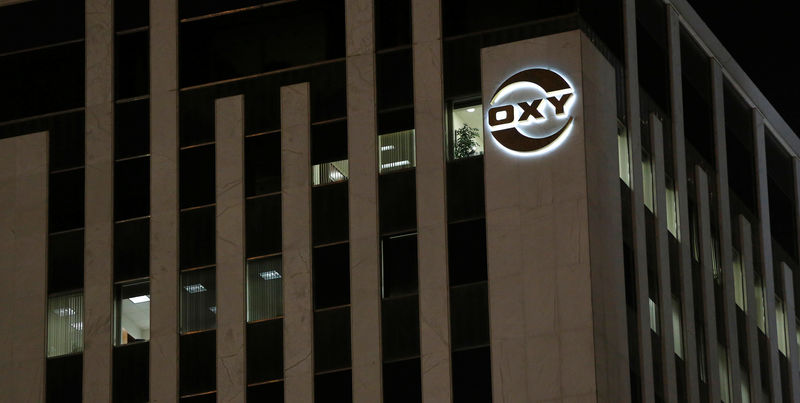By Devika Krishna Kumar and Florence Tan
NEW YORK/HOUSTON (Reuters) - Occidental Petroleum Corp (NYSE:OXY) has emerged as one of the biggest exporters of U.S. shale oil, rivalling large trading firms and oil majors, in a market now worth more than $150 million every day.
It is showing no signs of slowing down, with plans to double crude exports to 600,000 barrels per day in 2020, Cynthia Walker, senior vice president midstream and marketing at Occidental, said in an interview.
"As we move into the end of this year and early in 2020 ... we'll probably see a doubling of exports over that period of time," she said.
In 2017, Occidental was the largest exporter of crude produced in the Permian oilfield of Texas and New Mexico, the largest U.S. oil field, from the U.S. Gulf Coast.
Through 2018, it remained one of the top three exporters of U.S. crude, according to limited customs data on Refinitiv Eikon analysed by Reuters and exclusive interviews with company executives and employees.
Company-level data on exports is notoriously guarded and kept secret. The U.S. Census Bureau declined to provide data, citing a law which protects confidentiality.
Occidental stands out among the myriad trading houses, oil producers and shippers with operations in the Permian, as it currently exports about 300,000 bpd of oil, roughly 10 percent of U.S. crude exports.
According to limited Customs data available on Refinitiv Eikon, other top shippers included Koch Supply and Trading, BP (LON:BP) Plc’s trading arm and Trafigura AG.
Occidental produces significant volumes of oil in the Permian - and its marketing arm buys barrels from other Permian shale producers. In addition, it has contracts for long-term shipments on pipelines and access to storage and export terminals as well.
"We touch anywhere between 20 and 25 percent of every barrel that's produced in the Permian basin," Walker said.
EXPORT BOOM BRINGS OPPORTUNITY
U.S. crude exports have skyrocketed after Washington lifted a decades-long ban of exports in late 2015, rising at a rate faster than many anticipated to a record at about 3.6 million bpd last month. (Graphic: U.S. crude exports surge to record - https://tmsnrt.rs/2F0CVck)
U.S. oil production has risen by more than 2 million bpd in the last 12 months, also to an all-time high of over 12 million bpd, according to U.S. Energy Department data. Given the country consumes several million barrels more than that daily, many analysts had assumed exports would grow more slowly.
That has not been the case - exports have doubled from the end of 2017, a lucrative opportunity for companies with access to supply and export terminals.
Companies are scrambling to build Gulf Coast ports to handle more than 3 million bpd in new supplies expected over the next five years.
Profits at Occidental's midstream and marketing segment, which includes exports, surged more than seventeen-fold to $1.9 billion in 2018, excluding items, mostly thanks to moving crude from the Permian to the refining and export hub in the Gulf Coast.
As oil retreated to around $50 a barrel, Occident shares ended 2018 down more than 15 percent, closely tracking the weakness in oil prices.
While Occidental cashed in last year, rivals ran into bottlenecks trying to get barrels from Permian to the Gulf Coast for export due to a lack of adequate pipeline access. That caused regional prices to slump, even as the price of U.S. oil futures rose to more than $75 a barrel at one point. The bottleneck has since eased as companies expanded pipelines.
Oxy has a 10-year service agreement with BridgeTex pipeline, a key conduit to move crude from the Permian. The company secured a deal for 200,000 bpd of space in 2012 and has financed the line's construction.
Last year, Oxy not only sent its own barrels, but bought those of others. Pioneer Natural Resources (NYSE:PXD) Co, a rival Permian producer, sold 17 percent of their production to Occidental Marketing in 2018, according to regulatory filings. Occidental also bought a massive 34 percent of the barrels Pioneer buys from other companies.
The company also had the advantage of owning and operating a terminal in Ingleside, Corpus Christi, where it began testing supertanker export capabilities in 2017. Oxy later sold the terminal to Moda Midstream but has retained a 10-year contract for 450,000 bpd of exports at the oil export terminal.
The company has the ability to send about 470,000 bpd out of the Permian via pipelines and expects to add more capacity in 2019, Chief Executive Vicki Hollub said at an industry conference last year.
The port partially loaded its first supertanker - Nasiriyah chartered by Occidental for Europe - in December which helped slash costs for ship-to-ship transfers, a costly endeavour that has limited U.S. exports because most Gulf terminals are not deep enough to handle the supertankers, known as Very Large Crude Carrier (VLCC) as they can transport 2 million barrels of oil, desired by Asian buyers.
"We don't worry at all about access," Walker said, adding that the company has a 75-cent per barrel advantage on loading costs due to the loading efficiencies at the Ingleside terminal.
To boost its export capability, Moda is expanding its storage and considering building a second berth for VLCCs.
"We're trying to get as much to the Gulf and get it out of there," a source at Occidental said.

"We have the place that is easily accessible - at Ingleside - that really is what they're using to market to these foreign players in Asia."